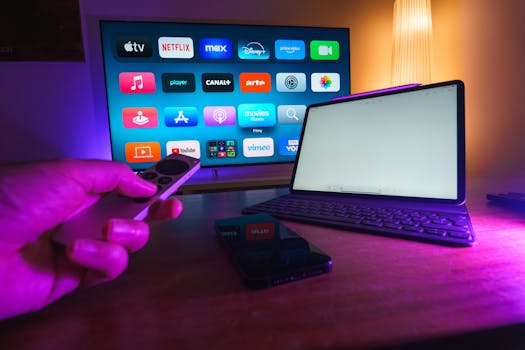Wellness
Best Sleep Tracker Apps for Deeper Rest and Better Mornings
Explore the best sleep tracker apps and actionable tips for customized rest. Boost daily wellness, track your sleep data, and transform sluggish mornings into energized, healthy starts right now.
Advertisement
Ever wake up feeling groggy, then wonder what actually happened during your night’s rest? Sleep tracker technology now works quietly on your phone to reveal smarter rest patterns.
Understanding your unique sleep rhythm makes it easier to pinpoint habits that help or hinder deep rest. Good sleep shapes everything—from focus at work to your long-term health—so getting it right matters every day.
If you want sharper mornings, personalized insights, and better recovery, explore how a sleep tracker can turn night data into daily wellness improvements. Let’s dig into the best apps and habits for restful nights.
Building a Nighttime Routine with Sleep Tracker Apps
Following a consistent nightly routine guided by your sleep tracker gives you measurable results and smoother mornings. Let’s look at steps you can use to design yours.
Start by setting your device where it won’t disturb your rest but still capture accurate movement and sound cues. Track this placement for three nights and compare the quality of data collected.
Mini Checklist: Reliable Placement and Device Prep
First, check your mattress firmness. If it’s too soft, movement tracking drops. Lay your device next to your pillow or at the bedside. Notice if your sleep tracker shows fragmented sleep patterns. Try moving the device, then review your tracker’s summary afterward.
Charge your device before bed. Enable airplane mode to reduce blue light and distractions. Make a quick note on your tracker about your mood before sleep—it’ll help spot stress-sleep links in the morning.
Set the tracker to silent notifications after setting a wake time. Doing so lets the tracker gently nudge you awake with vibrations or soft alarm tones without breaking sleep cycles too early.
Scenario: Tweaking Routine for Better Data
After placing his phone under his pillow, Raul found his sleep tracker marked too many disturbances. He tried shifting the device to his nightstand. Immediately, his tracker’s sleep graphs leveled out. He also muted notifications, noticing fewer awakenings and more REM sleep time.
Emily logs her tea intake on her sleep tracker app as a quick note. After a week, she sees on her tracker’s morning dashboard that nights with caffeine delay her deep sleep time—so she now stops herbal tea an hour before bed for calmer nights.
When reading real tracker summaries, compare changes after each tweak. A simple “slept better, woke up smoother” is worth noting in your app for trend tracking. Try the same tonight.
| App Name | Key Feature | Best For | Takeaway |
|---|---|---|---|
| Sleep Cycle | Smart alarm for light sleep wake-ups | Busy professionals | Try the in-app mood log before bed |
| Pillow | Detailed sleep stage visualization | Apple device users | Connect your smartwatch for enhanced accuracy |
| SleepScore | Sound-based tracking (no wearable) | Those who don’t like wrist devices | Place the phone at chest level for optimal results |
| AutoSleep | Automatic session detection | Passive overnight tracking | No need to press ‘start’ or ‘stop’ every night |
| ShutEye | Snore and talk detection | Light sleepers and snorers | Listen to sleep sounds captured by your app each morning |
Analyzing Data: What Your Sleep Tracker Numbers Mean for You
Interpreting outputs from a sleep tracker unlocks clear trends and actionable steps for improvement. Sleep stage graphs, trends, and scorecards guide you to what’s actually working in your routine—and what needs a tweak.
Sleep trackers show stages like REM, light, and deep sleep using color blocks or percentage charts. Matching your energy levels to these results each day helps pinpoint what your body most needs for real restoration.
Deepening Insight: Pattern Recognition in Sleep Tracker Data
Look for trends spanning at least a week. For instance, if your tracker’s deep sleep time dips every Thursday, think about weekday habits—maybe a late workout or a noisy apartment neighbor?
Notice sharp drops in your tracker’s total sleep or increases in interruptions. Mark those nights with a short note. You’ll see if they match changes in diet, stress, hydration, or bedtime habits.
- Explore week-long patterns on your tracker—not just single nights—for more accurate insights about your habits.
- Match energy levels each morning with your tracked sleep stages to spot direct cause-effect improvements or setbacks.
- Update your tracker notes with context when routines shift; holiday travel or new daily stressors make a visible difference on your graphs.
- Compare weekend and weekday sleep duration to see how your social life impacts rest and recovery using your sleep tracker summaries.
- Create your own score system alongside the tracker’s: green for smooth days, yellow for tired ones, red if you needed extra coffee.
Tracking the “why” behind sleep changes gives your app context—and helps you act immediately. Adjusting earlier, based on patterns, prevents recurring sleep struggles.
Spotting What Works: Action Steps from Your Tracker
When your tracker shows rising deep sleep, correlate that with your bedtime adjustment, meal timing, or mindfulness exercise. Copy the most restful schedule into another week to test if gains continue.
If the sleep tracker marks too many awakenings, create a wind-down routine: turn off electronics 45 minutes prior, dim lights, and log your day in a journal. After three nights, use tracker results as feedback.
- Turn off major lights 30 minutes before bed to signal wind-down mode and check if your tracker logs faster sleep onset time.
- Listen to a five-minute meditation before sleep. Your tracker may show reduced awakenings.
- Keep room temperature consistent; review whether your tracker rewards you with longer REM cycles compared to previous weeks.
- Limit liquids one hour before bedtime and note a drop in bathroom interruptions per your tracker’s nightly summary.
- Add one new healthy habit per week (like reading or gratitude journaling) and use the tracker for feedback on relaxation impact.
Testing changes with tracker data ≠ guessing. You’ll learn which adjustments instantly show better mornings—a relief for anyone tired of trial and error.
Daily Life Benefits of Understanding Your Sleep Tracker Score
When you follow the right tracker cues, improvements spill into each area of your life—sharper work focus, improved mood, and more motivation for physical activity.
The more you learn from your tracker’s feedback, the less sleep becomes a mystery. Every day, you notice patterns and plan your routine around what brings deeper rest and consistent wake-ups.
Boosting Energy with Predictable Sleep Patterns
James set his wake-up window based on the tracker’s “best wake time” summary. He stuck to it for two weeks, and his afternoons grew more focused. The tracker, now set up better, reliably shows fewer interruptions and more energy consistency.
Sophia realized her tracker always showed her deepest sleep from 11 p.m. to 1 a.m., so now she avoids screen time an hour before bed. Her data improved; so did her mood at breakfast, with stable energy for her morning workout.
Aligning daily habits with your tracker’s proven trends means less second-guessing. You get repeatable positives—alertness, motivation, and steady physical performance—just by reviewing and changing evening routines.
Reducing Stress by Tracking Sleep and Mood Together
Logging pre-bed stressors in your sleep tracker creates visible connections. Over a month, Chris saw that stressful workdays led to restless nights. Now, he uses a five-minute breathing routine before lights-out, comparing the tracker’s restfulness each morning.
Adding a micro-journal in your tracker or wellness app supports identifying triggers for disrupted sleep—like late emails or complex conversations. Small habit swaps based on regular review help you ease stress physically and mentally.
Pair your sleep tracker data with a mood check-in for 14 days. Mark sleep quality and rate your mood. You’ll see which days felt easy and which needed support, then plan stress reducers proactively.
Choosing the Best Sleep Tracker App for Your Needs
Finding the right sleep tracker app depends on your lifestyle, tech preferences, and what insights motivate you. Consider what you need daily—a gentle alarm, sound detection, integrations, or passive tracking.
Each app offers unique feedback. Some sync with fitness trackers, others rely just on your phone. Reviewing these options helps you match features to your wellness goals right away.
Scenario: Selecting Your Sleep Partner
Sarah prefers a tracker with a morning trends report and an intuitive dashboard. She tried two apps for a week each. The first overwhelmed her with details; the second fit her preference for simple summaries and offered a smart alarm. She chose clarity over excess info.
After years with a fitness wearable, Mike tried a sound-based tracker app instead. He wanted less to charge and wear. Placing his phone on his nightstand improved comfort and gave a snore analysis, which he used to adjust sleep position for quieter nights.
Test at least two apps for a week. Track ease-of-use, setup time, and the value of the insights. Quickly narrow down to the tracker that aligns with your real routine.
Actionable Comparison Points
If you like seeing bite-size advice, search for a tracker app with ‘daily sleep tips’. For accuracy fanatics, test apps that sync seamlessly with a wearable. Compare sound-based track results to movement-based graphs for your specific sleep environment.
Choose apps with simple export features on your tracker, especially if you want to share trends with healthcare professionals later. If snoring or sleep talking is an issue, prioritize sound analysis to catch audio cues accurately. Each adjustment sharpens your insights and results.
Match your sleep tracker experiment to goals—gentle alarms, snore detection, detailed graphs, or mood integration. You’ll find the right fit through hands-on use and by tracking results for more restful nights as you go.
Easy Habits to Enhance Your Sleep Tracker’s Effectiveness
Making the most of your sleep tracker doesn’t require drastic changes. Small, nightly habits lead to more precise data and healthier rest—improving both your wellness score and your energy the next morning.
Start with one change at a time: adjust your bedtime, add a relaxing soundscape, or dim the room lights. Review your tracker results for three nights before layering on a second habit.
Mini Checklist: Daily Sleep Tracker Boosts
Pick a 15-minute wind-down activity, like reading or stretching, and stick to it for a week. Mark on your tracker app how you feel each morning. If rest improves, keep the habit; if not, switch gears quickly.
Keep your device’s software and tracker app updated for optimal performance. Adjust permissions to ensure consistent night tracking; this avoids gaps in your rest data. Review your summary before breakfast to see small, actionable tips from your tracker each day.
Check your device placement weekly. If your tracker’s summaries show unusual dips or spikes, shift placement—like from bedside to pillow edge—and see if readings stabilize for sharper sleep trends.
Refreshing Results with Monthly Review
Every four weeks, export your sleep tracker data and look for patterns alongside life events: new job, vacation, or seasonal weather. Pinpoint if those shifts altered your rest or left data gaps worth troubleshooting.
If your tracker shows erratic results, revisit app permissions and phone routines; maybe your phone updated or you changed something else. Regular checks prevent tracking errors and help maintain the most useful data for continued wellness improvement.
Pair visual cues—graphs, color-coded scores—with your physical energy to lock in new, sustainable sleep habits. Sleep tracker reviews at regular intervals spark new tweaks that foster lasting, rejuvenating rest.
Lasting Change: Your Path to Better Sleep Starts Here
Building a mindful wind-down with a sleep tracker brings you sharp, personalized insights for real-world wellness wins. Each tweak creates visible improvements—fewer morning yawns, better mood, and vibrant days fueled by deeper rest.
Your commitment to learning from your sleep tracker shapes lasting habits. Simple steps—routine refinement, pattern recognition, and targeted nightly changes—quickly build positivity throughout your wellness journey.
This week, choose one tracker-backed tweak. Stick with it, log results, and celebrate small gains using your sleep tracker app for proof. The path to deeper rest and better mornings is simple: start, track, and repeat for lasting wellness.
Trending Topics

How to Improve Sleep Hygiene with Mobile Tools
Strengthen your sleep hygiene with mobile tools that manage bedtime habits and improve nightly rest quality.
Keep Reading



